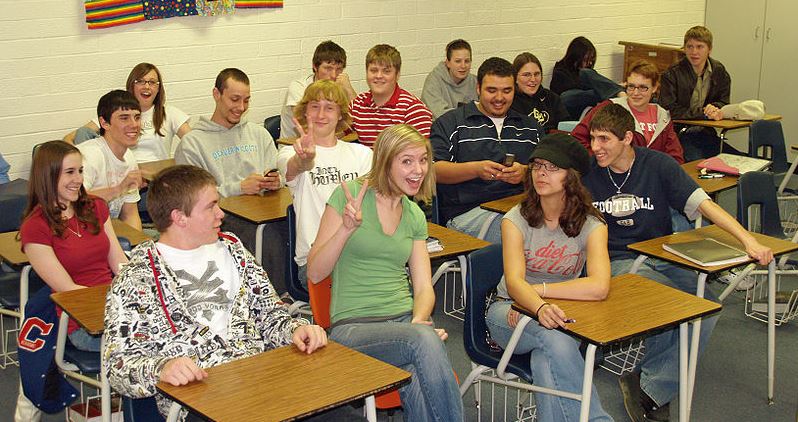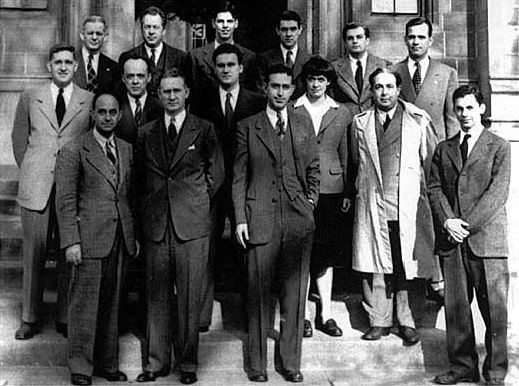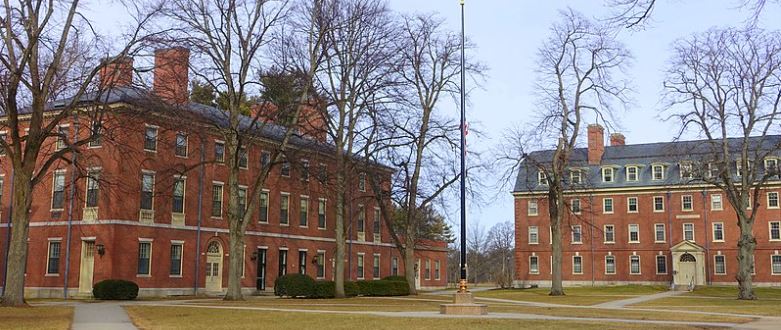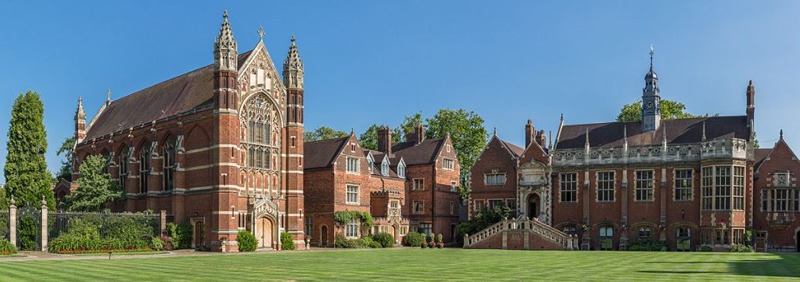Table of Contents
BACKGROUND
The American education system remains a source of envy to the rest of the world. With its diversity and excellence, the American education system attracts students and visitors from all corners of the globe. The U.S. education system has also become a model system for the rest of educational development in other nations worldwide.
In higher education alone, the flexibility of their system provides different institutional features and innovations offered to the students. The diversity allows learners to focus on various academic training and employment opportunities.

MIT students

U.S. high school seniors

The signing of the No Child Left Behind Act

U.S. school children in 2000
Unlike other nations, American higher education institutions are not centrally organized or managed.
These institutions are accredited nationally or nationally by independent accrediting bodies.
Over 4,000 accredited institutions comprise higher education in America [1].
HISTORY
Understanding and appreciating American education is something that the world will embrace, noting the rich history of its growth from the European settlers who came and established the schools in the 15th century up to the current times. Below is the chronological history of how the American education system was first established, how it evolved, and how it became a model for the world today [2]:
THE AMERICAN EDUCATIONAL STRUCTURE
The American education system is inherently rich in academic choices for local and international students. The wide array of schools and programs for the students enabled the development of its educational stages and plans [3].
1. Primary and secondary school
U.S. students attend primary and secondary school for a combined total of 12 years.
About six years old, an American child begins primary school, commonly called elementary school. They attend five or six years before they proceed onto secondary school.
The secondary school comprises two programs: the first is a middle school or junior high school, and the second is a high school.
A diploma or certificate will be given upon graduation from high school. After graduating high school or 12th grade, a U.S. student may attend college or university. College or university study is known as higher education.
2. Grading system
A student will have to submit academic transcripts as part of college or university admission. Academic transcripts are official copies of the student’s academic work, covering the grades and grade point average (GPA).
This GPA is a measurement of a student’s academic achievement.
Courses are commonly graded using percentages, which are converted into letter grades.
For international students, the grading system and GPA in the U.S. can be a source of confusion because of variation in the interpretation of grades.
For instance, two students graduated from different schools and submitted their transcripts to the same university with the same 3.5 GPAs.
However, the school might have a different interpretation of the GPA between a student who attended an average high school and a prestigious school.
International students have to check the U.S. equivalent of the last level of education they finished in their home country.
Give extra attention to the admission requirements of each university and college and their individual degree programs. They will have different requirements compared to a university.
Talk to an educational advisor or guidance counselor to guide you in working out the admission requirements.
The U.S. may not recognize international students’ admission. Thus, these international students need to inquire in advance of their eligibility.
3. Academic year
The school calendar in the United States usually starts in August or September and continues through May or June.
The majority of new students start in autumn. The academic year in most schools consists of two terms known as semesters. Other schools have a trimester in their academic year. Others have their year using the quarter system of four terms, including the summer session, which is optional.
LEVEL OF STUDY IN U.S. HIGHER EDUCATION
1. First Level: Undergraduate
The undergraduate level is for a student going to a college or university and has not received a bachelor’s degree yet.
Typically, it is earned within four years of study.
You can either earn your bachelor’s degree at a four-year university or college or a community college.
The first two years of study would be required to take a wide variety of classes in different subjects or prerequisite courses.
These subjects include literature, science, the social sciences, the arts, history, and so forth. Enrollment in this subject provides general knowledge, or a foundation, to a student learning various subjects before focusing on a specific field of study.
Many students pick community college for their first two years of prerequisite courses. They would earn an Associate of Arts (AA) transfer degree. Afterward, they would move to a four-year university or college.
The specific field of study is called a major. It is the focus of the degree.
For instance, if someone’s major is journalism, he will earn a Bachelor of Arts in Journalism.
A student will be required to take a certain number of courses in this field to meet the degree requirements of the major field he chooses.
A student picks his major at the start of his third year of school. A student can change his major many times if he decides on it. This is one of the unique characteristics of the U.S. higher education system.
It is common for U.S. students to change majors at some point in their undergraduate years.
They do this when they find the major they enjoy studying along the way. This system makes U.S. education a flexible one.
However, switching majors and courses entail more resources and time lost.
2. Second Level: Master’s Degree
A student who finished college or a university graduate with a bachelor’s degree may enroll in the second level of higher education called graduate study. The students will do this to attain higher or advanced learning in their careers. This degree is usually needed for higher-level positions, such as library science, engineering, behavioral health, and education.
International students must ask for information about the credentials needed to get a job in the country before applying to a postgraduate university in the USA.
This graduate program is part of a university or college. A student must take the GRE (graduate record examination) to enroll. Other master’s programs need students to take specific examinations, like the LSAT for law school, the GRE or GMAT for business, and the MCAT for medical school.
The graduate programs leading to a master’s degree usually take one to two years to finish.
For instance, the Master of Business Administration (MBA) is a widely known master’s degree program that takes about two years. A master’s degree in Journalism only takes one year.
Most of a master’s program is done in classroom study, and a graduate student must prepare a long research paper known as a master’s thesis or finish a master’s project.
3. Third Level: Doctorate Degree
Completing a master’s degree will lead the students to pursue further studies, known as Ph.D. or doctorate. However, students may prepare directly for a doctorate at other universities without getting a master’s degree.
It may take three years or more for a student to get a Ph.D. degree. For international students, it may take five or six years.
The doctoral program will cover classes and seminars for the first two years.
At least another year is reserved for firsthand research and writing a thesis or dissertation. This dissertation must contain views, designs, or research that have not been previously published.
A doctoral dissertation discusses and summarizes the current scholarship on a given subject or topic.
Many American schools with doctorate programs require their candidates to have a reading knowledge of two foreign languages.
Also, they want the students to spend a required time in residence, pass a qualifying examination that officially admits candidates to the Ph.D. program, and pass an oral test on the same topic as the dissertation.
U.S. EDUCATION FROM A GLOBAL PERSPECTIVE
In the article Education at a Glance 2021: Putting U.S. Data in a Global Context, it was seen that the United States is above the international average in some aspects of educational development, like participation in and funding of postsecondary education. However, the report also shows the U.S. lagging behind in other measures, like participation in early childhood education programs [4].
The report is contained in the Education at a Glance, a yearly publication produced by the Organization for Economic Cooperation and Development (OECD). The journal gives data on the structure, finances, and performance of education systems in 38 OECD countries, including America.
The report contains state-level data on vital benchmarks to inform nations and local policies on global competitiveness.
The recently released 2021 edition of the Education at a Glance report shows:
1. Postsecondary Educational Attainment
The percentage of U.S. 25- to 34-year-olds with a postsecondary degree increased by 10 percentage points between 2010 and 2020, reaching 52 percent, compared with the OECD average of 45 percent.
The attainment rates are not the same across the United States in 2020.
In the United States in 2020, 25- to 34-year-old women were more likely to get a postsecondary education than 25- to 34-year-old men.
A total of 57 percent of women had a postsecondary qualification, compared with 47 percent of men, a difference of 10 percentage points.
In other OECD countries, the postsecondary education gap between 25- to 34-year-old men and women was wider (13 percentage points) than the gap in the United States (10 percentage points).
In 2020, the postsecondary attainment rate of 25- to 34-year-old men in the United States was 8 percentage points higher than the OECD average, whereas the rate of 25- to 34-year-old women in America was 5 percentage points higher than the OECD average.
2. Postsecondary Education Spending
The U.S. government spends much on postsecondary education. The spending is relatively high compared to the OECD average, in absolute and relative terms.
In 2018, the American government spent $34,036 per postsecondary student. The expenditure is the second-highest after Luxembourg and nearly double the OECD average ($17,065).
Furthermore, the U.S. spending on post-secondary education as a percentage of GDP (2.5 percent) was substantially higher than the OECD average (1.4 percent). These total expenditures include amounts received from governments, students, and all other sources.
3. Early Childhood Education
In the area of Early Childhood Education, the level of participation in the United States is below the OECD average and falling further behind.
For context, between 2005 and 2019, the average enrollment rates for 3- to 5-year-olds across OECD countries increased from 77 to 87 percent.
In contrast, America’s Early Childhood Education rate remained stable at 66 percent during this period.
Among U.S. states, the 2019 enrollment rates for 3- to 5-year-olds ranged from less than 50 percent in Idaho and North Dakota to 70 percent or more in New York (70 percent), Vermont (76 percent), Connecticut (76 percent), New Jersey (77 percent), and the District of Columbia (88 percent).
Despite the full closure of schools in 37 OECD and partner nations in 2020 due to the pandemic, the share of NEETs (those neither in employment nor education nor training) among 18- to 24-year-olds did not greatly increase in most OECD countries’ partner nations.
On average, the share of 18- to 24-year-old NEETs in OECD countries increased from 14.4 percent in 2019 to 16.1 percent in 2020.
However, Canada, Columbia, and the United States experienced an increase of more than 4 percentage points.
In the United States, the share of 18- to 24-year-old NEETs increased from 14.6 percent in 2019 to 19.3 percent in 2020.
In 2020, many postsecondary education institutions worldwide were closed, affecting more than 3.9 million international students studying in OECD countries.
In the U.S. alone, it was estimated that the percentage of international students attending postsecondary institutions in the U.S. declined by 16 percent between 2020 and 2021.
AMAZING FACTS ABOUT THE AMERICAN SCHOOLS
Below is the data on the K-12 public schools, districts, students, and spending on the education of students, among others, in the U.S. education system. The report is based on the 2017-18 National Center for Education Statistics (NCES).
These data give a wider perspective on the impact of U.S. policies on education [5].
(See data in separate tables as indicated)
How many schools are there in the U.S.?
All: 130,930
Elementary schools: 87,498
Secondary schools: 26,727
Combined schools: 15,804
Other: 901
How many are traditional public schools, public charter schools, or private schools?
Traditional public schools: 91,276
Public charter schools: 7,427
Private schools: 32,461
Among public schools, how many high schools are there in the U.S.?
Total public schools: 98,755
High schools: 21,497
Junior high schools: 2,375
Middle schools: 13,447
Elementary schools: 54,159
Combined schools: 6,586
Other: 691
What is the average public school size?
The average public school enrollment is 527 students.
What is the average public school size by type of location?
City: 585 students
Suburban: 656 students
Town: 443 students
Rural: 364 students
How many schools offer online courses?
A total of 21% of public schools, including charters, offer at least one course entirely online.
Almost a third (30.3%) of charter schools offer an entire course online versus 20.2% of traditional public schools.
How many school districts are there?
There are 13,452 regular school districts in the U.S.
How many students attend public schools?
There are over 50.7 million students, based on federal projections for the fall of 2022.
How many students attend charter schools?
Almost 3.3 million students attend charter schools or 6.5 percent of all public school students.
How many students attend private schools? What are the religious affiliations of those schools?
In total, 5,719,990 students attend private schools, according to NCES 2017 data.
37.4% of those in Catholic schools
24.4% in nonsectarian (non-religious) schools
15.2% in unaffiliated religious schools
12.0% in conservative Christian schools
11.1% in other religiously affiliated schools
(Note: numbers may not add to 100 due to rounding.)
How many students are homeschooled?
There are an estimated 1,755,233 homeschooled students.
Where do most students attend school—the city, the suburbs, or rural areas?
Suburban: 39.6% of public school students
City: 30.3% of public school students
Rural: 19.2% of public school students
Town: 10.9% of public school students
Where do students mostly attend schools in the city?
City: 43.1% of private school students
Suburban: 39.9% of private school students
Rural: 10.5% of private school students
Town: 6.5% of private school students
What are the demographics of public school students?
What is the racial breakdown of the student population in American public schools as of 2018?
White students: 47.0%
Hispanic students: 27.2%
Black students: 15.1%
Asian students: 5.3%
Two or more race students: 4.1%
American Indian/Alaska Native students: 1.0%
Pacific Islander students: 0.4%
How many students have computers and internet access at home?
As of 2019, 98.1 percent of children ages 3-18 lived in a household with a computer or smartphone, and 94.6 percent lived in a home with internet access.
However, of the 94.6 percent, 6.5 percent only had the internet through a smartphone. In 2019, 5.4 percent of children ages 3-18 lived in a household without internet.
How many students graduate high school?
The national graduation rate is 86 percent, according to 2018-19 NCES data.
How has that changed over time?
The graduation rate has increased by 7 percentage points from 2010-2011 to 2018-19.
How many teachers are there in the U.S.?
According to federal projections, there will be over 3.2 million full-time-equivalent teachers in America’s public schools in the fall of 2022.
How many principals are there?
There are 90,850 public school principals in the U.S.
What percent of teachers are women?
Teaching continues to be a profession dominated by women.
According to 2017-18 numbers from NCES, 76.5 percent of teachers are female, while 23.5 percent are male.
What are the racial demographics of teachers?
79.3% White
9.3% Hispanic
6.7% Black
2.1% Asian
1.8% Two or more races
0.5% American Indian/Alaska Native
0.2% Native Hawaiian/ Pacific Islander
Who are U.S. public school principals?
Like teachers, most American principals are white and female.
53.7% Female
46.3% Male
77.7% White
10.5% Black
8.9% Hispanic
0.9% Asian
1.0% Two or more races
0.7% American Indian/Alaska Native
0.2% Native Hawaiian/ Pacific Islander
What’s the average U.S. teacher salary?
The average base salary for teachers is $57,900, according to 2017-18 data from NCES.
How does that compare with principals’ salaries?
According to 2017-18 data, the average public school principal salary is $98,300.
How big are the teachers’ unions?
According to NCES data from 2017-18, 69.4 percent of teachers are union members.
As of June 2019, the National Education Association had about 2.29 million full-time-equivalent members who are active educators or retirees.
What is the average student-to-teacher ratio in schools?
On average, in the fall of 2022, there will be 15.8 students assigned to a single teacher on average in public schools, NCES projections show.
How much does the U.S. spend on K-12 education?
In 2017-18, almost $735 billion was spent on public elementary and secondary education by local, state, and federal agencies.
How much is spent per pupil?
According to a study by Education Week, the nation spends $13,679 to educate each student.
REFERENCES:
[1] Education USA.state.gov, 2021. The US Educational System. Available at https://educationusa.state.gov/experience-studying-usa/us-educational-system [Accessed November 17, 2021].
[2] Eds-resources.com, 2021. Available at https://www.eds-resources.com/educationhistorytimeline.html [Accessed November 14, 2021].
[3] Study USA.com, 2021. Understanding the American Education System. Available at https://www.studyusa.com/en/a/58/understanding-the-american-education-system [Accessed November 17, 2021].
[4] NCES, 2021. Education At A Glance: Putting U.S Data In A Global Context. Available at https://nces.ed.gov/blogs/nces/post/education-at-a-glance-2021-putting-u-s-data-in-a-global-context [Accessed November 19, 2021].
[5] Ed Week.org, 2019. Facts About American Schools. Available at https://www.edweek.org/leadership/education-statistics-facts-about-american-schools/2019/01 [Accessed November 20, 2021].









